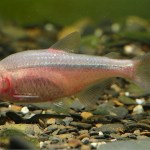circadian
Image of eyeless Mexican tetra fish from www.seriouslyfish.com by H-J Chen.
The metabolism of most animals follows a circadian rhythm that differs between the day and night. Mexican cavefish living in constant darkness, lost this circadian rhythm some time ago. In a newly published study in PLOS ONE, researchers compared the metabolic rate of both cave- and surface-dwelling Mexican tetra fish (Astyanax mexicanus). They hypothesized that since the fish living in each location naturally experience differences in food, predation as well as exposure to daily light fluctuations, they might also…
Blackbird image from: Ernie Janes/naturepl.com
A recent study has provided some evidence supporting the hypothesis that light and noise pollution alters the biological clocks of birds living in cities (compared to birds living in rural areas).
Dr. Dominoni (Max Planck Institute for Ornithology, Germany) and colleagues used radio-pulse transmitters attached to European blackbirds (Turdus merula) living in Munich, Germany (city) and those living in a forest nearby to track the animal's activity levels. They found that blackbirds living in the city showed significantly increased activity an…
Long-time readers of this blog remember that, some years ago, I did a nifty little study on the Influence of Light Cycle on Dominance Status and Aggression in Crayfish. The department has moved to a new building, the crayfish lab is gone, I am out of science, so chances of following up on that study are very low. And what we did was too small even for a Least Publishable Unit, so, in order to have the scientific community aware of our results, I posted them (with agreement from my co-authors) on my blog. So, although I myself am unlikely to continue studying the relationship between the…

